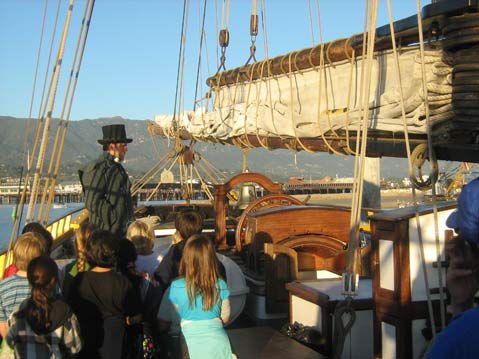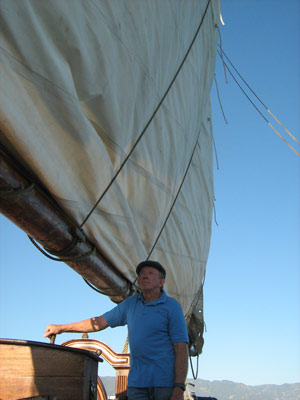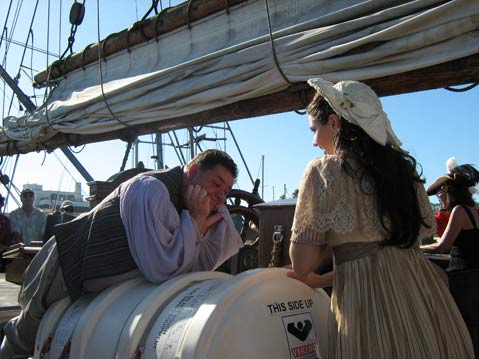Aboard the Spirit of Dana Point
Tall Ship a Lively Maritime History Classroom

This October, the Santa Barbara Maritime Museum hosted the Spirit of Dana Point, a replica of an 18th Century schooner owned by the Ocean Institute of Dana Point. The Tall Ship was a terrific classroom for a myriad of educational programs on sailing and maritime history. The Institute and Museum graciously invited me aboard for a sail, a swashbuckling opera preview, and a shift as a safety officer on an overnight in which local elementary students lived maritime history.
The Ocean Institute is a non-profit organization dedicated to teaching maritime history, environmental science, and archeology, mainly through what Sailing Coordinator Jody Williams calls “immersion-type living history.” The Tall Ship Education Program, where elementary school students spend a night on the ship recreating an 18th century voyage, is a perfect example of this teaching technique.
Besides programs designed for youngsters, the Spirit also invited sailors of all ages to participate in Sunday afternoon sails, during which all aboard served as deck hands raising sails, steering the ship, and witnessing a nerve-shattering canon firing.
Williams describes the Spirit as a replica of an “18th Century version of a Coast Guard cutter.” This is a ship from the Revolutionary War period, which served in the Revenue Cutter Service, protecting the coast by disabling pirate ships and the like. “It is very traditionally put together,” said Williams, adding that it is as loyal to the original design as possible and meant to operate like the old ship.

The Spirit of Dana Point has a very unusual history: Williams reports that Dennis Holland of Costa Mesa began constructing its parts in his front yard in 1970. The ship was launched in 1983, and the Ocean Institute acquired it in the mid-2000s. Williams said it is predominantly used for educational programs, including sails to Catalina Island with high school students.
Sailing the Tall Ship
My sail aboard the Tall Ship took place on an afternoon of impossibly gorgeous weather, even for a Santa Barbara October. Williams immediately informed me and my father and uncle, who were also aboard, that we would be expected to work on the Spirit, especially by helping raise the sails. And work we did, particularly my uncle, a seasoned seaman who once sailed from Sri Lanka to Indonesia in a similarly technologically basic vessel. He adeptly muscled up the sails, as I, standing behind, could barely keep the line between my hands.
Our skipper also allowed several crew members, young and old, to steer the ship. A preschool-age pirate was on hand to observe at close range the firing of the ship’s very realistic and loud canon.
At one point, as we sailed home to the harbor, a hush came over the Spirit of Dana Point, the only sound coming from the ship’s old bell. Something about the sound truly transported me back to the day’s of Richard Henry Dana’s voyage up the West Coast in the 1830s. (As if the authentically creaky wooden ship, canon balls, and orders the hoist the sails were not enough.)

A Worthy Stage for an Pirate Opera
One Sunday, members of the cast of Opera Santa Barbara’s production of Gilbert and Sullivan’s Pirates of Penzance gave a preview of the operetta on board the Tall Ship. Audience members hugged the edges of ship’s stern, making room for the singers to maneuver around and over nautical gear while belting out numbers like “I am the very model of a modern Major-General.” The singers’ spectacular talent, plus live accompaniment from Renee Hamaty on the keyboard, and their very appropriate songs and costumes, made the performance an ideal addition to the Spirit’s activities in Santa Barbara.
The full-length performances of Pirates of Penzance, specially adapted for young mateys, were held at the Lobero Theater in November.
Students Participate in Living History Aboard Tall Ship
Two Years Before the Mast chronicles Richard Henry Dana’s experience aboard the Spirit-like tall ship Pilgrim as it traveled from Boston around Cape Horn to California on a hide-gathering voyage beginning in 1834. Local fourth and fifth grade students had the opportunity to read and then relive Dana’s odyssey through an overnight immersion program on the Spirit of Dana Point, during which they learned sailing and teamwork skills in a quintessential “living history” setting from educators dressed as 18th Century sea voyagers. Jody Williams calls the Ocean Institute’s technique during the overnight “question-based education,” explaining that the crew doesn’t feed the students information, but draws it out from them and encourages them to think critically.
About 450 local students participated in the Tall Ship Education overnight adventure. On the afternoon of the overnight, students arrived for a “muster,” at which point the first mate called the “green-hand sailors” aboard the ship, established the ship’s chain of command, and had the new sailors sign a contract confirming their two-year assignment aboard the Spirit of Dana Point. The children were divided into five groups, including hide gatherers and galley crew, in which they worked on projects. The galley crew aided the ship’s cook, who historically, Williams says, was also the doctor since he was adept with a knife. After dark, the children (and exhausted crew members) kept night watch in two-hour shifts.
Williams, cast, and crew stressed to the overnight’s adult chaperones the importance of staying in character to give the students the true experience of being transported back to the 1830s. The chaperones and I were known as safety officers and were asked not to interact with the students, in order to encourage them to solve problems by cooperating with their classmates. The experience was a unique practical opportunity for students to practice teamwork and follow complex instructions, as well as learn an enormous amount about maritime history.
The captain and first officers were tough, barking orders at the children and demanding perfect verbal responses. (“Aye!”) Chaperones whispered that the students seemed a bit “terrified” at first, but quickly adapted to the crew’s style and demonstrated maturity and practical thinking in their nautical tasks.
Hope School principal Barbara LaCorte accompanied a fourth-grade group on the overnight. Speaking afte hearing the students’ feedback at their “Ship Wreck Party” at Hope, following the night on the ship, she called the adventure a “reality TV-type experience” that the kids “took very seriously.” The challenging activities aboard the Spirit “stretched students beyond their comfort zone,” LaCorte said. The principal also liked that the outing was a “bonding experience with classmates and adults that they will never forget.”



